
The Chicago Water Tower is a contributing property and landmark in the Old Chicago Water Tower District in Chicago, Illinois, United States, that is listed on the National Register of Historic Places. Built to enclose the tall machinery of a powerful water pump in 1869, it became particularly well known when it survived the Great Chicago Fire of 1871, although the area around it was burnt to the ground.
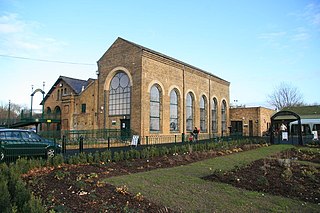
Markfield Road Pumping Station, now known as Markfield Beam Engine and Museum or sometimes just as Markfield Beam Engine is a Grade II listed building containing a 100 horsepower (75 kW) beam engine, originally built in 1886 to pump sewage from Tottenham towards the Beckton Works. The grounds of the building now form a public park known as Markfield Park. The River Moselle joins the River Lea at this location.

Downtown Louisville is the largest central business district in the Commonwealth of Kentucky and the urban hub of the Louisville, Kentucky Metropolitan Area. Its boundaries are the Ohio River to the north, Hancock Street to the east, York and Jacob Streets to the south, and 9th Street to the west. As of 2015, the population of downtown Louisville was 4,700, although this does not include directly surrounding areas such as Old Louisville, Butchertown, NuLu, and Phoenix Hill.
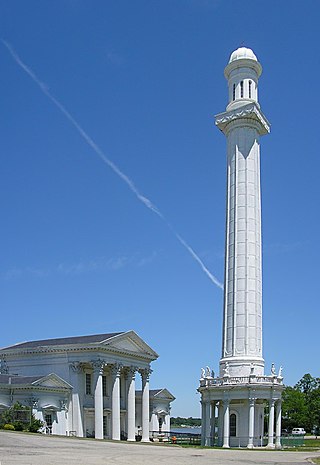
The Louisville Water Company is a water company based in Louisville, Kentucky.

TheGalt House Hotel is a 25-story, 1,300-room hotel in Louisville, Kentucky, established in 1972. It is named for a nearby historic hotel erected in 1835 and demolished in 1921. The Galt House is the city's only hotel on the Ohio River.
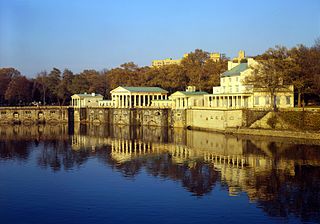
The Fairmount Water Works in Philadelphia, Pennsylvania, was Philadelphia's second municipal waterworks. Designed in 1812 by Frederick Graff and built between 1812 and 1872, it operated until 1909, winning praise for its design and becoming a popular tourist attraction. It now houses a restaurant and an interpretive center that explains the waterworks' purpose and local watershed history. It was designated a National Historic Landmark in 1976 for its architecture and its engineering innovations. It was the nation's first water supply to use paddle wheels to move water.

Central Park is a 17-acre (69,000 m2) municipal park maintained by the city of Louisville, Kentucky. Located in the Old Louisville neighborhood, it was originally the country estate of the DuPont Family. Early in its existence, the park was the site of the Southern Exposition, but later became mostly known for hosting the Kentucky Shakespeare Festival and northern portions of the annual St. James Court Art Show.
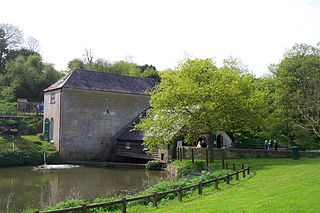
Claverton is a small village and civil parish about 2 miles (3 km) east of Bath at the southern end of the Cotswolds Area of Outstanding Natural Beauty, in Somerset, England. The parish has a population of 115.

The Wapping Hydraulic Power Station was originally run by the London Hydraulic Power Company in Wapping, London, England. Originally, it operated using steam, and was later converted to use electricity. It was used to power machinery, including lifts, across London. The Tower Subway was used to transfer the power, and steam, to districts south of the river.

London Museum of Water & Steam is an independent museum founded in 1975 as the Kew Bridge Steam Museum. It was rebranded in early 2014 following a major investment project.

Riverfront Plaza/Belvedere is a public area on the Ohio River in Downtown Louisville, Kentucky. Although proposed as early as 1930, the project did not get off the ground until $13.5 million in funding was secured in 1969 to revitalize the downtown area. On April 27, 1973, the Riverfront Plaza/Belvedere was dedicated. Running between Third and Sixth streets, it consisted of a large parking garage and the interstate, and a grassy 7-acre (28,000 m2) park built atop. The grassy park section on the western end was the Belvedere, and the Riverfront Plaza to the east included other attractions: fountains, shelters and an ice-skating rink, as well as buildings such as the Galt House, One Riverfront Plaza and the American Life Building.
The Kentucky Derby Museum is an American Thoroughbred horse racing museum located on the grounds of Churchill Downs in Louisville, Kentucky. Dedicated to preserving the history of the Kentucky Derby, it first opened its doors to the public in the spring of 1985. Much of its early funding came from a donation from the estate of James Graham Brown.

The Louisville Water Tower, located east of downtown Louisville, Kentucky, near the riverfront, is the oldest ornamental water tower in the world, having been built before the more famous Chicago Water Tower. Both the actual water tower and its pumping station are a designated National Historic Landmark for their architecture. As with the Fairmount Water Works of Philadelphia, the industrial nature of its pumping station was disguised in the form of a Roman temple complex.

The United States Marine Hospital in Louisville, Kentucky, in the Portland neighborhood was built in 1845, and is considered by the National Park Service to be the best remaining antebellum hospital in the United States.

The Minne Lusa Residential Historic District is located in North Omaha, Nebraska. It is included on the National Register of Historic Places. According to the National Park Service, it is an "example of a substantial, affordable single-family residential development within the city limits that was platted, developed and constructed by a single firm between 1915 and 1941." The neighborhood is filled with bungalows, Craftsman, and other styles that were popular in the era. There are 540 properties in the neighborhood that contribute to the historic district, the other 167 do not. Minne Lusa Boulevard is a contributing structure.

The Shreveport Waterworks Pumping Station, also known as the McNeil Street Pump Station, is a historic water pumping station at 142 North Common Street in Shreveport, Louisiana. Now hosting the Shreveport Water Works Museum, it exhibits in situ a century's worth of water pumping equipment, and was the nation's last steam-powered waterworks facility when it was shut down in 1980.

The Shore Road Pumping Station is a pumping station in Birkenhead, on the Wirral Peninsula, England.

The East Market District, colloquially referred to as NuLu, is an unofficial district of Louisville, Kentucky, situated along Market Street between downtown to the west, Butchertown to the north, Phoenix Hill to the south, and Irish Hill to the east. The area is home to schools, churches, large and small businesses and some of the city's oldest homes and businesses. A destination since Louisville's founding, Market Street has played host to a variety of businesses throughout the city's history that have drawn Louisvillians for generations to its addresses.

The Palace Theatre is a music venue in downtown Louisville, Kentucky, located in the city's theater district, on the east side of Fourth Street, between Broadway and Chestnut Street. It has a seating capacity of 2,800 people and is owned by Live Nation. The historic landmark opened on September 1, 1928, and was designed by architect John Eberson. It was originally known as the Loew's and United Artists State theatre.
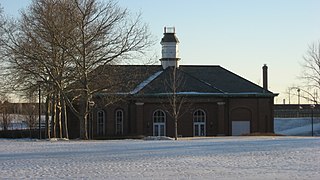
West Washington Street Pumping Station is a historic pumping station located in Indianapolis, Indiana. It was built in 1870, and is a one-story, rectangular brick building. It was modified to its present form after 1909, and is 2/3 of its original size. It has a slate hipped roof topped by a square central tower and features distinctive brick detailing, and arched openings. The building served as the city's only water pumping station until 1890.

















